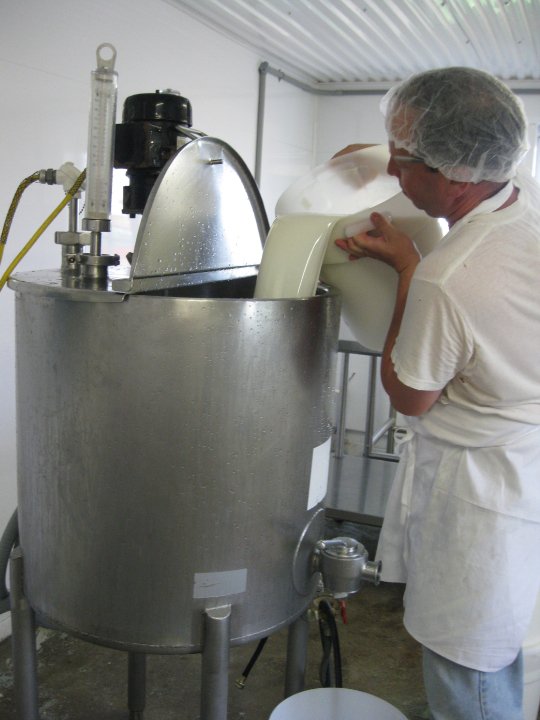June is Dairy Month—the time we all celebrate our favorite food group by drinking a glass of milk or eating ice cream. And we should celebrate! New York is the country’s third largest producer of dairy products, after California and Wisconsin. Dairy generates more than half of the state’s agricultural income. Furthermore, we are fortunate to live in an area with a rich history of dairy farming and cheese production. The Mohawk Valley was once the center of the cheese making universe (or at least in the US). Prices for the entire Eastern seaboard were set in downtown Little Falls from 1853 to 1875. Upstate New York was once dotted with thousands of small dairy farms and hundreds of little “crossroads” cheese factories—places where dairy farmers could easily and quickly transport their milk for processing.
Peter pouring milk into one of our vat pasteurizers.
Of course change comes to every industry, and dairy is no exception. Before mechanical refrigeration, farmers had to pack ice around their cans of milk to keep them cold, limiting the distance they could reasonably travel with their precious cargo. During World War I, gas refrigeration made it possible to ship farmer’s fluid milk much greater distances via railroad car, and the population explosion and resulting demand in New York City meant the milk went downstate, signaling the end of all those little, independent cheese factories. Over the last 50 years, the dairy industry has undergone even more change and consolidation. In fact, our state has lost over half of its dairy farmers in just the last 20 years. Although there are far fewer farms, those that remain are larger and produce thousands more pounds of milk than their predecessors.
>
“(New York State) has lost over half of its dairy farmers in just the last 20 years.”
It has never been easy to be a dairy farmer, and today is no exception. Unless you are a dairy farmer or know someone in the business, you may not be aware that farmers here in the Mohawk Valley have taken a 30-50% pay cut in recent months. Fluid milk in this country is treated as a commodity and priced according to a government formula. This formula is not clearly linked to inflation, cost of living or even cost of production. The price fluctuates—as all commodity prices do—but when supply is greater than demand and there is a surplus of milk as there is now, prices plummet.
Dairy farmers are paid by the “hundred weight” or per 100 pounds of milk (cwt) picked up at the farm. To put this in perspective, 100 pounds of milk equals approximately 11.6 gallons. Prices last fall were in the $26-30/cwt range for conventional, Class “1” milk and are now in the $14-18 range, depending on components like protein and butterfat. According to Hoard’s Dairyman, the average cost to make 100 pounds of milk is $17.50. Again, to put this number in perspective, it costs the farmer $1.50 to make that gallon of milk you buy at the grocery store. At today’s low price, many area farms are operating at a loss. Even worse, the surplus of milk in today’s global marketplace means an unfortunate few have been dropped by their processors and cooperatives altogether, meaning they’ve had to scramble to find a new buyer for their milk…or dump it altogether.
With this in mind, I spoke with a handful of our dairy farmer friends and asked them what they would like the general public to know as we celebrate “June the Dairy Month”. They all said they love their jobs and their animals. They want everyone to know that they take great pride in producing a safe, high-quality product that they in turn feed their own families. They explained how they are subject to multiple inspections from their buyers or cooperatives, and federal and state government agencies. Their milk is rigorously tested for antibiotics, somatic cell counts, and bacteria; and the farmer suffers significant financial consequences if they ship milk that does not meet strict standards. They work closely with their veterinarians to maintain optimal herd health. They are producing some of the safest, most healthful milk ever made.
But they also expressed frustration. They see some consumers have lost faith in the quality of their milk, due in part to bad information deliberately spread in the marketplace and to the fact that so few people are connected to farming anymore. They are frustrated with a pay system that often leaves them with too small a check and too many bills at the end of the month. As one farmer saw it, he believes he and his wife will be the last generation to milk on the farm that his grandfather built. Their children have no interest in dairy—having heard too many times over the years that the milk check won’t cover expenses, who can blame them?
>
“…the future can be bright, if we appreciate our dairy farmers and support them now, while we still can.”
How does the future of dairy look in the Mohawk Valley? I asked a farming advocate friend of mine what she thought. She believes that the future can be bright, if we appreciate our dairy farmers and support them now, while we still can. We have the infrastructure and people associated with dairy in place—not just the farmers, but the veterinarians, ag schools, machinery dealers, mechanics, and truck drivers. Just as importantly, we have water (unlike the drought-ravaged West) and are rich in grasslands. We have the ability to positively affect dairy in our own backyard—by supporting our dairy farmer neighbors, talking to them, understanding their challenges, and by paying attention to the Farm Bill. We must do something to support dairy in our state in a meaningful way, and quickly. For me, celebrating “June the Dairy Month” just took on a whole new, much more significant meaning.
